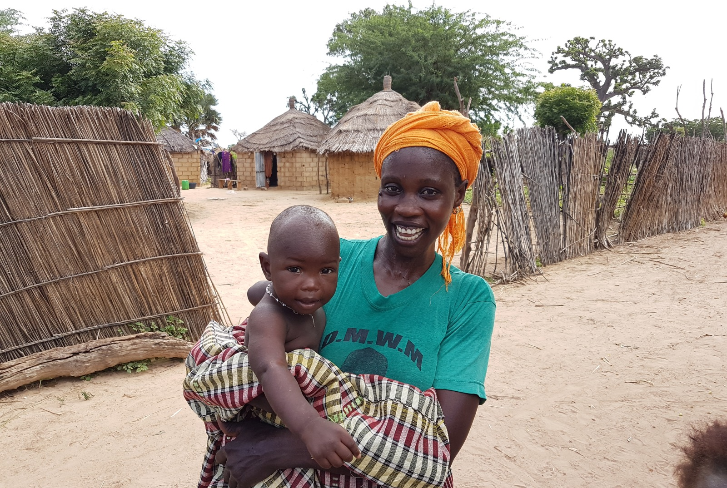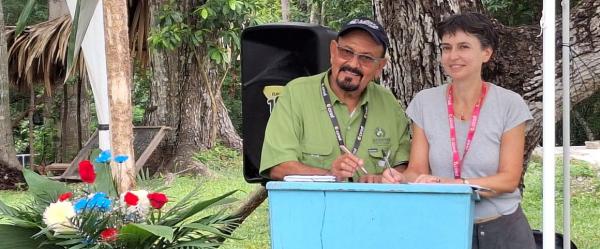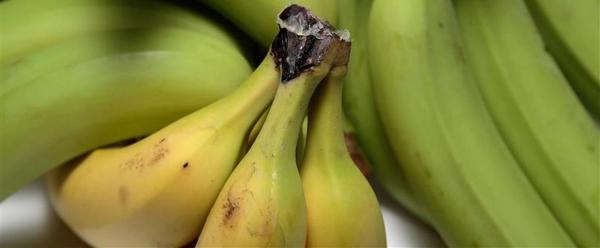Science at work 20 November 2025
- Home
- Press area
- Press releases
- Boosting micronutrients in food to address malnutrition in the Sahel
Boosting micronutrients in food through agroecology to address malnutrition in the Sahel

Mother and child in Senegal © C. Dangléant, CIRAD
In sub-Saharan Africa almost half of all children under five suffer from micronutrient deficiency, especially in vitamin A, zinc and iron, which limits their development, health and future working capacity, according to WHO. This is also known as “hidden hunger”. Ethiopia is ranked lowest (IFPRI, 2017) in terms of diet quality for infants (aged 6 to 23 months). In Senegal, micronutrient deficiencies, especially in zinc, affect one in three young women and more than half of all children under the age of five. The origin of this malnutrition is linked to the lack of diversity in traditional diets, which are low in fruit and vegetables (perishable and expensive) and in animal products. This impaired growth and cognitive function weighs heavily on the development of these countries. The African Union Commission estimates productivity losses at 11% of GDP on average in African countries.
Micronutrients monitored from the field to the plate
This is a problem that Senegal and Ethiopia have decided to tackle, through an ambitious experiment, from the field to the plate.
"The idea behind the OR4FOOD project is to monitor three essential micronutrients, from the field to the plate: zinc, iron and vitamin A ”, says Jean-Michel Médoc, an agronomist at CIRAD and coordinator of the project. “We are going to monitor these micronutrients in the cultivation of two commonly consumed cereal crops, millet and teff, which will be associated with legumes, such as peas in Ethiopia and cowpeas in Senegal, but also orange fleshed sweet potato ”. This tuber is not yet grown or consumed in the two target regions of the project. Yet it is high in beta-carotene, a precursor of vitamin A. The introduction of this variety is one of the innovative aspects of the project."
Associating varieties that are naturally high in micronutrients with organic fertilisers
« L’autre originalité sera de proposer des systèmes de cultures agro-écologiques, associant des variétés naturellement riches en micronutriments à des pratiques de fertilisation organique. »
Tout un panel de leviers agro-écologiques sera ainsi évalué au champ, en station expérimentale et dans un réseau de parcelles paysannes. Il s’agira de :
- combine the crop varieties that are naturally the highest in micronutrients with the local organic matter that also contains the highest levels of these nutrients,
- mobilise local microorganisms to increase the transfer of micronutrients from organic matter to plants,
- optimise associations of these crops to maximise the nutritional yield from plots.
Preserving micronutrients during processing
Finally, the project will look at food processing and preservation methods (wholemeal flour for young children).
Whether for cropping systems or food processing methods, the goal will be to select the most efficient systems and procedures in terms of nutritional yield and those that are the easiest for the target rural populations to adopt.
To assess this, different measurements of micronutrient quantities will be conducted both in food products – at all stages of their production chain up to processing and the assessment of their bioavailability for the human organism – and in the environment. As noted by Jean-Michel Médoc, “the micronutrients contained in organic fertilisers can potentially pollute the environment if the plants do not fully assimilate them ”. The environmental sustainability of the practices implemented will therefore also be assessed.
The project will be implemented through innovative platforms in which farmers, food processors, researchers, nutritionists and beneficiary populations will work together.
OR4FOOD will be launched in Ethiopia at Addis Ababa University from 26 to 28 February 2019. Attendees will include members of the project, the French embassy and the African Union, representatives of Addis Ababa University and of the Ethiopian Ministries of Agriculture and Environment, and actors involved in combating hidden hunger.
OR4FOOD in a nutshell OR4FOOD is coordinated by CIRAD and financed by the African Union Research Grants programme. It involves agronomists from CIRAD, IRD and ISRA, as well as experts in food and nutritional science from ITA and UCAD in Senegal and Addis Ababa University in Ethiopia. These teams have taken up the challenge of micronutrient biofortification of commonly consumed local food products in Africa, working with farmers to implement agro-ecological selection of varieties that are naturally high in micronutrients along with organic fertilisation. Two regions are targeted by the project: the Kaffrine region in Senegal and the Oromia region in Ethiopia. The people living in these poor, rural regions have a cereal-based diet, which may sometimes include only one food product during the drought period (up to 9 months in the Kaffrine region). |



























